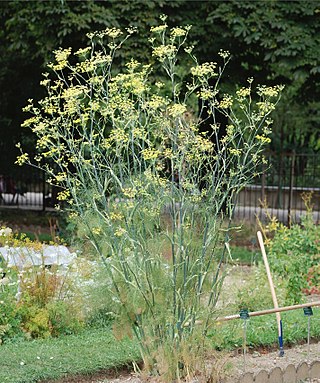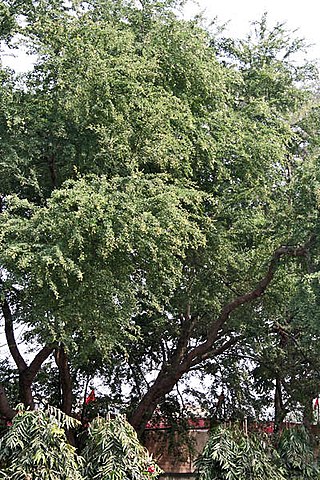
Oregano is a species of flowering plant in the mint family Lamiaceae. It was native to the Mediterranean region, but widely naturalised elsewhere in the temperate Northern Hemisphere.

Stevia is a natural sweetener and sugar substitute derived from the leaves of the plant species Stevia rebaudiana, native to Paraguay and Brazil.

Fennel is a flowering plant species in the carrot family. It is a hardy, perennial herb with yellow flowers and feathery leaves. It is indigenous to the shores of the Mediterranean but has become widely naturalized in many parts of the world, especially on dry soils near the sea-coast and on riverbanks.

Agave americana, common names century plant, maguey, or American aloe, is a species of flowering plant in the family Asparagaceae, native to Mexico and the United States in Texas. It is cultivated worldwide as an ornamental plant, and has been naturalized in many regions, including parts of Southern California, the West Indies, South America, Mediterranean Basin, Africa, Canary Islands, India, China, Thailand, and Australia.

Aloysia citrodora, lemon verbena, is a species of flowering plant in the verbena family Verbenaceae, native to South America. Other common names include lemon beebrush. It was brought to Europe by the Spanish and the Portuguese in the 17th century and cultivated for its oil.

Stevia rebaudiana is a plant species in the genus Stevia of the family Asteraceae. It is commonly known as candyleaf, sweetleaf or sugarleaf.

Panela or rapadura is an unrefined whole cane sugar, typical of Central and Latin America. It is a solid form of sucrose derived from the boiling and evaporation of sugarcane juice. Panela is known by other names in Latin America, such as chancaca in Chile, Bolivia, and Peru, piloncillo in Mexico. Just like brown sugar, two varieties of piloncillo are available; one is lighter (blanco) and one darker (oscuro). Unrefined, it is commonly used in Mexico, where it has been around for at least 500 years. Made from crushed sugar cane, the juice is collected, boiled, and poured into molds, where it hardens into blocks. Elsewhere in the world, the word jaggery describes a similar foodstuff. Both are considered non-centrifugal cane sugars.

The white sapote, scientific name Casimiroa edulis, also called casimiroa and Mexican apple, and known as cochitzapotl in the Nahuatl language is a species of tropical fruiting tree in the family Rutaceae, native to eastern Mexico and Central America south to Costa Rica. The genus is named for "an Otomi Indian, Casimiro Gómez, from the town of Cardonal in Hidalgo, Mexico, who fought and died in Mexico's war of independence."

Phyla is a genus of eustarid plants in the verbena family, Verbenaceae. The name is derived from the Greek word φυλή (phyle), meaning "tribe", and most likely refers to the tightly clustered flowers or the spreading, mat-like growth. Members of the genus are known generally as fogfruit or frogfruit. Species once classified in the genus Lippia may be known by the common name lippia. Some species, e.g. Aztec Sweet Herb, are used in cooking.

Lippia is a genus of flowering plants in the verbena family, Verbenaceae. It was named after Augustus Lippi, (1678-1705), a French naturalist and botanist. He was killed in Abyssinia. The genus contains roughly 200 species of tropical shrubs that are found around the world. Plants are fragrant due to their essential oils, which vary between species but may include estragole, carvacrol, linalool, or limonene. The leaves of certain species, such as L. graveolens, can be used as a culinary herb similar to oregano.

Phyla nodiflora, the frog fruit, sawtooth fogfruit, or turkey tangle, is a flowering plant in the family Verbenaceae, and is native to the area from northern South America to southern United States. It can be found in tropical areas around the globe, a naturalized species in many places. This plant is cited in Flora Brasiliensis by Carl Friedrich Philipp von Martius.

Pithecellobium dulce, commonly known as Manila tamarind, Madras thorn, monkeypod tree or camachile, is a species of flowering plant in the pea family, Fabaceae, that is native to the Pacific Coast and adjacent highlands of Mexico, Central America, and northern South America. It is also sometimes known as monkeypod, but that name is also used for several other plants, including Samanea saman. It is an introduced species and extensively naturalized in the Caribbean and Florida, as well as the Philippines and Guam via the Manila galleons. It has also been introduced to Thailand and South Asia, It is considered an invasive species in Hawaii.

Tagetes lucida is a perennial plant native to Mexico and Central America. It is used as a medicinal plant and as a culinary herb. The leaves have a tarragon-like scent, with hints of anise, and it has entered the nursery trade in North America as a tarragon substitute. Common names include sweetscented marigold, Mexican marigold, Mexican mint marigold, Mexican tarragon, sweet mace, Texas tarragon, pericón, yerbaniz, and hierbanís.

Hernandulcin is an intensely sweet chemical compound gained from the chiefly Mexican and South American plant Lippia dulcis.
Gymnemic acids are a class of chemical compounds isolated from the leaves of Gymnema sylvestre (Asclepiadaceae). They are anti-sweet compounds, or sweetness inhibitors. After chewing the leaves, solutions sweetened with sugar taste like water.

Lippia alba is a species of flowering plant in the verbena family, Verbenaceae, that is native to southern Texas in the United States, Mexico, the Caribbean, Central America, and South America.

Lippia graveolens, a species of flowering plant in the verbena or vervain family, Verbenaceae, is native to the southwestern United States, Mexico, and Central America as far south as Nicaragua. Common names include: Mexican oregano, redbrush lippia, orégano cimarrón, scented lippia, and scented matgrass. The specific epithet is derived from two Latin words: gravis, meaning 'heavy', and olens, meaning 'smelling'. It is a shrub or small tree, reaching 1–2.7 m (3.3–8.9 ft) in height. Fragrant white or yellowish flowers can be found on the plant throughout the year, especially after rains.

Mexican tea culture is known for its traditional herbal teas which are reputed to have medicinal properties. In recent decades, imported tea beverages have also become popular in Mexico. Mexican tea recipes have grown in popularity beyond Mexico as well.
(+)-epi-α-Bisabolol synthase (EC 4.2.3.138) is an enzyme with systematic name (2E,6E)-farnesyl-diphosphate diphosphate-lyase (cyclizing, (+)-epi-α-bisabolol-forming). This enzyme catalyses the following chemical reaction

Stevia is a genus of about 240 species of herbs and shrubs in the family Asteraceae, native to subtropical and tropical regions from western North America to South America.















